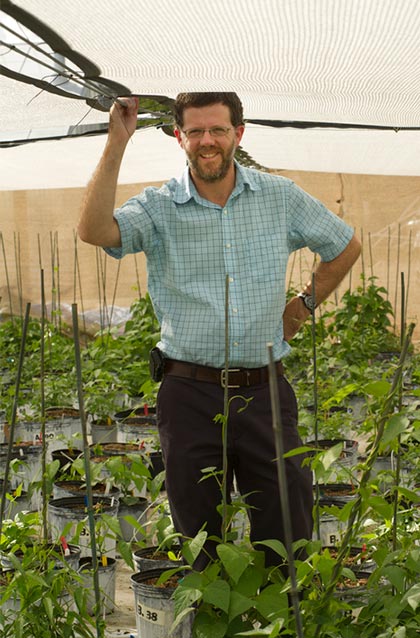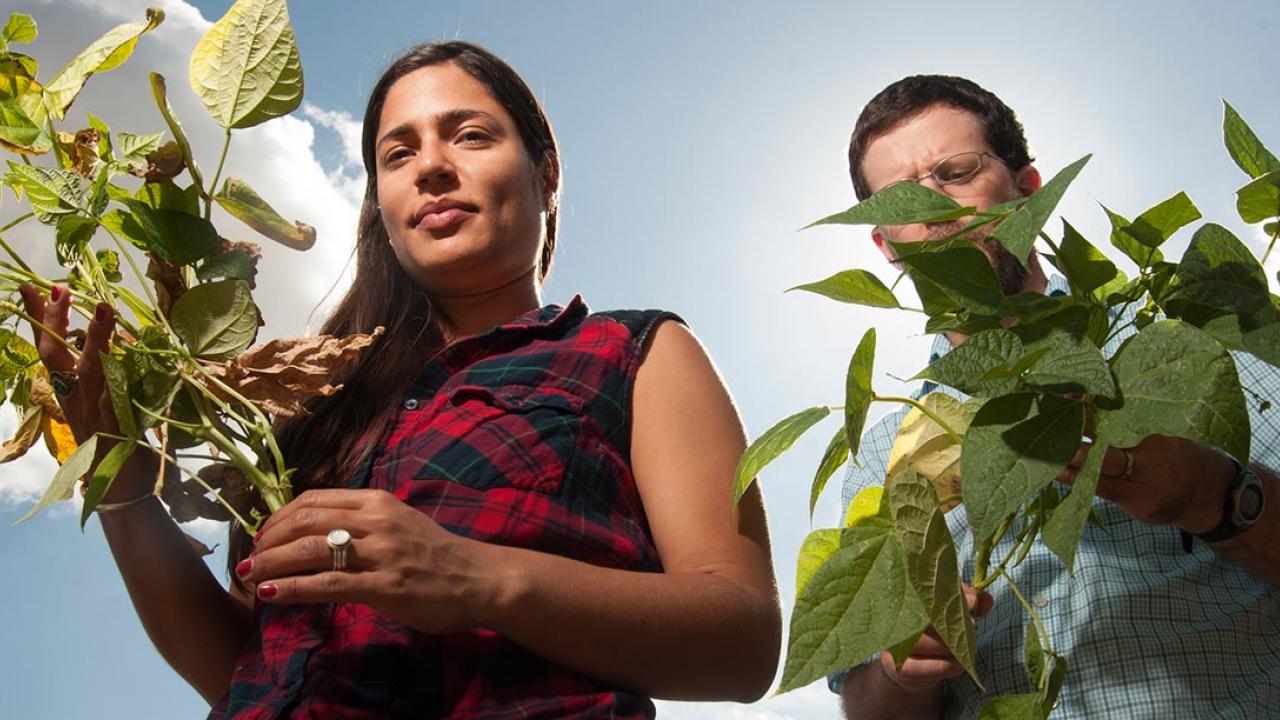
A team of UC Davis researchers is raising the roof to understand and measure exactly how the two most popular types of dry beans deal with drought stress.

Their goal is to develop a bean that can better withstand the effects of drought and climate change in California and beyond.
Crop physiologist and Assistant Professor Matthew Gilbert and graduate student Viviana Medina, both of the Department of Plant Sciences, have constructed a special outdoor greenhouse with a retractable shade, where they can simulate drought for 50 different genotypes of beans.
The new facility became a necessity when their collection of 1,000 plants in 500 pots exceeded the capacity of UC Davis’ expansive greenhouse and shade house facilities. Growing the plants in pots is important for controlling certain aspects of drought, but the new outdoor greenhouse now allows the researchers to provide covering for the young seedlings while removing the shade from the adult plants to better simulate drought as it occurs in the field,
“It’s been quite boundary pushing because no one does these things outside,” Gilbert says. “No one does them in pots in the full sun. No one does it with a soil that’s more representative of the field than the greenhouse.”
Dry beans in California
Dry beans are important for California, which annually produces 60,000 tons of them on about 50,000 acres. In times of drought, crops like dry beans are often the first to be targeted for fallowing, and they have already been significantly reduced in the parts of California hit hardest by the severe drought.
Although lima beans and the common dry bean, which includes kidney, pinto and other varieties, use a considerable amount of water to achieve high yields, they already have some degree of drought tolerance built into their genes.
The best climate-change breed
Gilbert and Medina are confident that their large collection of drought-challenged bean plants will yield the data needed for selecting and developing the best candidates for a new generation of dry bean varieties that can survive drought conditions.
The new outdoor greenhouse is home to bean varieties from around the world, both wild and domestic. Their pots are painted white so the sun won’t overheat the soil. This summer,
the greenhouse shade was drawn back to expose the adult plants to the intense light and temperature of the Sacramento Valley, and the plants were cut off from water for a week.
“Drought stress is a lack of water, but in the real world it occurs with high light and high temperature,” Gilbert says. “In California, which is much more reliably irrigated, it’s probably water conservation rather than stress tolerance that would be important if the bean must be adapted to do one thing.”
Intense heat stresses and wilts plants
Under the stress of drought, the temperature of the individual leaves rose to as high as 115 degrees Fahrenheit, well beyond the air temperature, causing a few plants to show heat stress and wilting early in the simulated drought.
“We thought we were going to be seeing more damage, but apparently they’re doing pretty well, considering,” Medina says. “While we want them to suffer, we want most of them to be able to recover.”
The researchers also planted the Native American tepary bean to monitor its drought adaptation strategies. As a separate goal, Medina is studying water conservation in the plants, with the hope of separating those characteristics from the heat and light stress-tolerance traits.
A bean for the California drought
Gilbert has been collaborating with the UC Davis bean-breeding program run by Professor Paul Gepts and his laboratory team. Graduate students Jorge Berny Mier y Teran and Sarah Dohle have been developing some of the genotypes used in the experiment. The findings from the study conducted by Gilbert and Medina will also help the Gepts Lab in its breeding efforts. Over the coming years, the Gilbert team continually will refine the experimental bean population and eventually develop a new, hardier bean variety that can be released to California farmers.
“We hope to establish the boundaries of how well-adapted we can make beans to drought,” Gilbert says. “And through our collaboration with the bean-breeding program, we aim to be prepared for the next major drought.”
UC Davis is growing California
At UC Davis, we and our partners are nourishing our state with food, economic activity and better health, playing a key part in the state’s role as the top national agricultural producer for more than 50 years. UC Davis is participating in UC’s Global Food Initiativelaunched by UC President Janet Napolitano, harnessing the collective power of UC to help feed the world and steer it on the path to sustainability.
